Numerical Analysis of Frost Heave and Thaw Settlement for Pipeline Buried in Frost-Susceptible Soil via Thermosiphons
Abstract
:1. Introduction
2. Frost-Heave Model and Thermosiphon Model
2.1. TM Model: Unfrozen Water Content of Soil
2.2. TM Model: Porosity Rate Function
2.3. TM Model: Constitutive Model
2.4. Thermosiphon Model
3. User Subroutine for TM Model
3.1. Component of User Subroutines
3.2. Implementation of the Constitutive Model in the TM Model
3.3. Implementation of the Thermal Model for the TM Model
4. Finite Element Analysis Method and Results
4.1. Soil Behavior Scenarios and Modeling
4.2. Frost-Heave Scenario
4.3. Thaw-Settlement Scenario
5. Conclusions
Author Contributions
Funding
Conflicts of Interest
References
- Li, H.; Lai, Y.; Wang, L.; Yang, X.; Jiang, N.; Li, L.; Wang, C.; Yang, B. Review of the State of the Art: Interactions Between a Buried Pipeline and Frozen Soil. Cold Regions Sci. Technol. 2019, 157, 171–186. [Google Scholar] [CrossRef]
- Konrad, J.M.; Morgenstern, N.R. A Mechanistic Theory of Ice Lens Formation in Fine-Grained Soils. Canad. Geotech. J. 1980, 17, 473–486. [Google Scholar] [CrossRef]
- Lytton, R.L.; Pufahl, D.E.; Michalak, C.H.; Liang, H.S.; Dempsey, B.J. An Integrated Model of the Climatic Effects on Pavements; Federal Highway Administration Report No. FHWA-RD-90-033; Federal Highway Administration: Washington, DC, USA, 1993.
- O’Neill, K.; Miller, R.D. Numerical Solutions for a Rigid-Ice Model of Secondary Frost Heave; CRREL Report 82-13, U.S. Army Corps of Engineers; Cold Regions Research and Engineering Laboratory: Hanover, NH, USA, 1982. [Google Scholar]
- Sheng, D. Thermodynamics of Freezing Soils: Theory and Application. Doctoral Dissertation, Luleå University of Technology, Luleå, Sweden, 1994. 141 D. [Google Scholar]
- Hartikainen, J.; Mikkola, M. General Thermomechanical Model of Freezing Soil with Numerical Application. In Ground Freezing 97; Frost Action in Soils; Balkema: Rotterdam, The Netherlands, 1997; pp. 101–112. [Google Scholar]
- Michalowski, R.L. A Constitutive Model of Saturated Soils for Frost Heave Simulations. Cold Regions Sci. Technol. 1993, 22, 47–63. [Google Scholar] [CrossRef]
- Selvadurai, A.P.S.; Hu, J.; Konuk, I. Computational Modelling of Frost Heave Induced Soil–Pipeline Interaction II. Modelling of Experiments at the Caen Test Facility. Cold Regions Sci. Technol. 1999, 29, 229–257. [Google Scholar] [CrossRef]
- Dallimore, S.R. Observation and Predictions of Frost Heave around a Chilled Pipeline. Doctoral Dissertation, Carleton University, Ottawa, ON, Canada, 1985. [Google Scholar] [CrossRef]
- Ming, F.; Yu, Q.H.; Li, D.Q. Investigation of Embankment Deformation Mechanisms in Permafrost Regions. Transport. Geotech. 2018, 16, 21–28. [Google Scholar] [CrossRef]
- Peng, H.; Ma, W.; Mu, Y.H.; Jing, L. Impact of Permafrost Degradation on Embankment Deformation of Qinghai-Tibet Highway in Permafrost Regions. J. Central South Univ. 2015, 22, 1079–1086. [Google Scholar] [CrossRef]
- Park, D.S.; Shin, M.B.; Seo, Y.K. Frost Heave of Frost Susceptible Soil According to Performance of Thermo-syphon. J. Kor. Geotech. Soc. 2021, 37, 27–40. [Google Scholar] [CrossRef]
- Andersland, O.B.; Ladanyi, B. Frozen Ground Engineering, 2nd ed.; John Wiley & Sons, Inc.: Hoboken, NJ, USA, 2004. [Google Scholar]
- Alizadehdakhel, A.; Rahimi, M.; Alsairafi, A.A. CFD Modeling of Flow and Heat Transfer in a Thermosyphon. Int. Comm. Heat Mass Transf. 2010, 37, 312–318. [Google Scholar] [CrossRef]
- Fadhl, B.; Wrobel, L.C.; Jouhara, H. Numerical Modelling of the Temperature Distribution in Two-phase Closed Thermosyphon. Appl. Therm. Eng. 2013, 60, 122–131. [Google Scholar] [CrossRef] [Green Version]
- Jafari, D.; Filippeschi, S.; Franco, A.; Di Marco, P. Unsteady Experimental and Numerical Analysis of a Two-phase Closed Thermosyphon at Different Filling Ratio. Exp. Therm. Fluid Sci. 2017, 81, 164–174. [Google Scholar] [CrossRef]
- Abdalla, B.A.; Mei, H.; McKinnon, C.; Gaffard, V. Numerical Evaluation of Permafrost Thawing in Arctic Pipelines and Mitigation Strategies. In Proceedings of the Arctic Technology Conference, St. John, NL, Canada, 24–26 October 2016. [Google Scholar] [CrossRef]
- Abdalla, B.; Fan, C.; McKinnon, C.; Gaffard, V. Numerical Study of Thermosyphon Protection for Frost Heave. In Proceedings of the ASME 34th International Conference on Ocean, Offshore and Arctic Engineering (OMAE2015), St. John, NL, Canada, 31 May–5 June 2015. [Google Scholar] [CrossRef]
- Xu, J.; Eltaher, A.; Jukes, P. Three-dimensional FE Model for Pipeline in Permafrost with Thermosyphon Protection. In Proceedings of the Arctic Technology Conference, Houston, TX, USA, 7–10 February 2011. [Google Scholar] [CrossRef]
- Park, D.S.; Shin, M.B.; Seo, Y.K. Development of Numerical Analysis Model for the Calculation of Thermal Conductivity of Thermo-syphon. J. Kor. Geotech. Soc. 2021, 37, 5–15. [Google Scholar] [CrossRef]
- Jang, C.; Choi, C.; Lee, J.; Lee, C. Evaluation on Thermal Performance of Thermosyphon by Numerical Analysis. J. Kor. Geotech. Soc. 2014, 30, 57–66. [Google Scholar] [CrossRef]
- Lee, J.; Lee, C.; Jang, C.; Choi, C. Experimental and Numerical Investigation of the Performance of Vertical Thermosyphon for Frozen Ground Stabilization. J. Kor. Geosynth. Soc. 2014, 13, 45–56. [Google Scholar] [CrossRef]
- Zhang, Y.; Michalowski, R.L. Thermal-Hydro-Mechanical Analysis of Frost Heave and Thaw Settlement. J. Geotech. Geoenviron. Eng. 2015, 141, 04015027. [Google Scholar] [CrossRef]
- Huang, L.; Sheng, Y.; Wu, J.; Cao, W.; Peng, E.; Zhang, X. Experimental Study on Mechanical Interaction Between Buried Pipe and Soil During Freezing. Cold Regions Sci. Technol. 2020, 178, 103129. [Google Scholar] [CrossRef]
- Michalowski, R.L.; Zhu, M. Frost Heave Modeling Using Porosity Rate Function. Int. J. Num. Analyt. Methods in Geomech. 2006, 30, 703–722. [Google Scholar] [CrossRef] [Green Version]
- Dongqing, L.; Xing, H.; Feng, M.; Yu, Z. The Impact of Unfrozen Water Content on Ultrasonic Wave Velocity in Frozen Soils. Proc. Eng. 2016, 143, 1210–1217. [Google Scholar] [CrossRef]
- Tice, A.R.; Anderson, D.M.; Banin, A. The Prediction of Unfrozen Water Contents in Frozen Soils from Liquid Limit Determinations; CRREL Report 76-8, U.S. Army Corps of Engineers; Cold Regions Research and Engineering Laboratory: Hanover, NH, USA, 1976. [Google Scholar]
- Henry, K.S.; Zhu, M.; Michalowski, R.L. Evaluation of Three Frost Heave Models. In Proceedings of the Seventh International Conference on the Bearing Capacity of Roads, Railways and Airfields (BCRA’05), Trondheim, Norway, 25–27 June 2005. [Google Scholar]
- Henry, K.S. The Use of Geosynthetics to Mitigate Frost Heave in Soils. Ph.D. Dissertation, Civil Engineering Department, University of Washington, Seattle, WA, USA, 1998. [Google Scholar]
- Da Re, G.; Germaine, J.T.; Ladd, C.C. Triaxial Testing of Frozen Sand: Equipment and Example Results. J. Cold Regions Eng. 2003, 17, 90–118. [Google Scholar] [CrossRef]
- Zhao, X.D.; Zhou, G.Q.; Chen, G. Triaxial Compression Strength for Artificial Frozen Clay with Thermal Gradient. J. Central South Univ. 2013, 20, 218–225. [Google Scholar] [CrossRef]
- Ong, K.S.; Goh, G.; Tshai, K.H.; Chin, W.M. Thermal Resistance of a Thermosyphon Filled with R410A Operating at Low Evaporator Temperature. Appl. Therm. Eng. 2016, 106, 1345–1351. [Google Scholar] [CrossRef]
- Zhang, Y. Thermal-Hydro-Mechanical Model for Freezing and Thawing of Soils. Doctoral Dissertation, The University of Michigan, St. Ann Arbor, MI, USA, 2014. [Google Scholar]
- Fukuda, M.; Kim, H.S.; Kim, Y.C. Preliminary Results of Frost Heave Experiments using Standard Test Sample Provided by TC8. In Ground Freezing 97; Frost Action in Soils; Balkema: Rotterdam, The Netherlands, 1997; pp. 25–30. [Google Scholar]
- Kosky, P.; Balmer, R.T.; Keat, W.D.; Wise, G. Exploring Engineering, 3rd ed.; Academic Press: Waltham, MA, USA, 2013. [Google Scholar] [CrossRef]
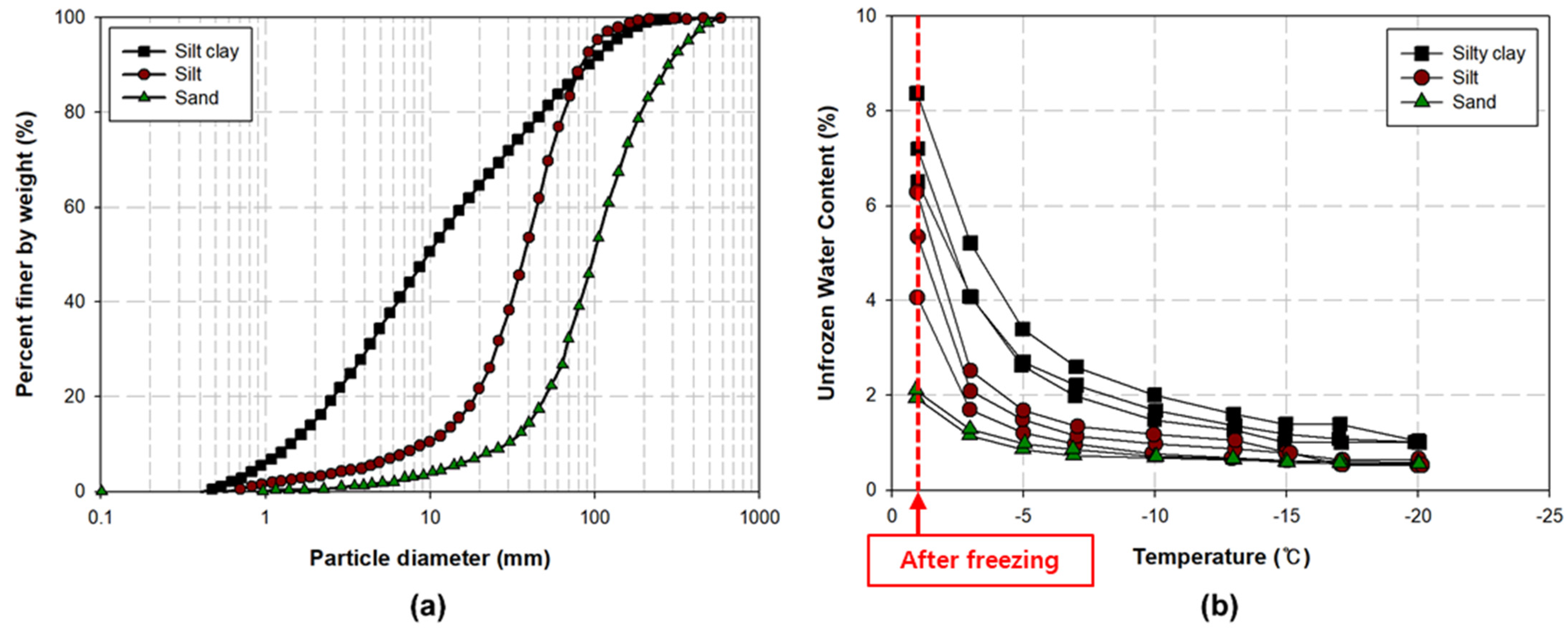
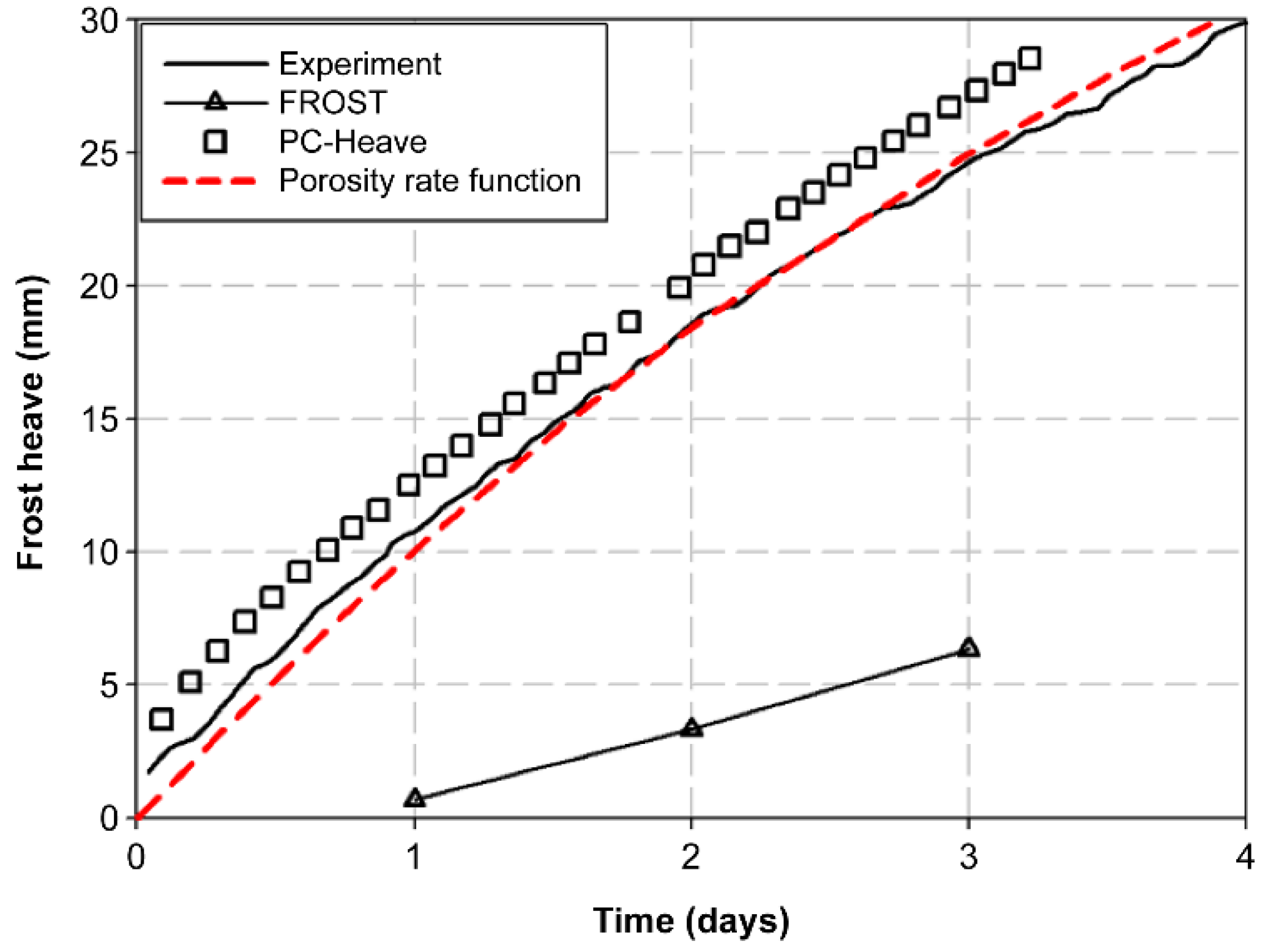
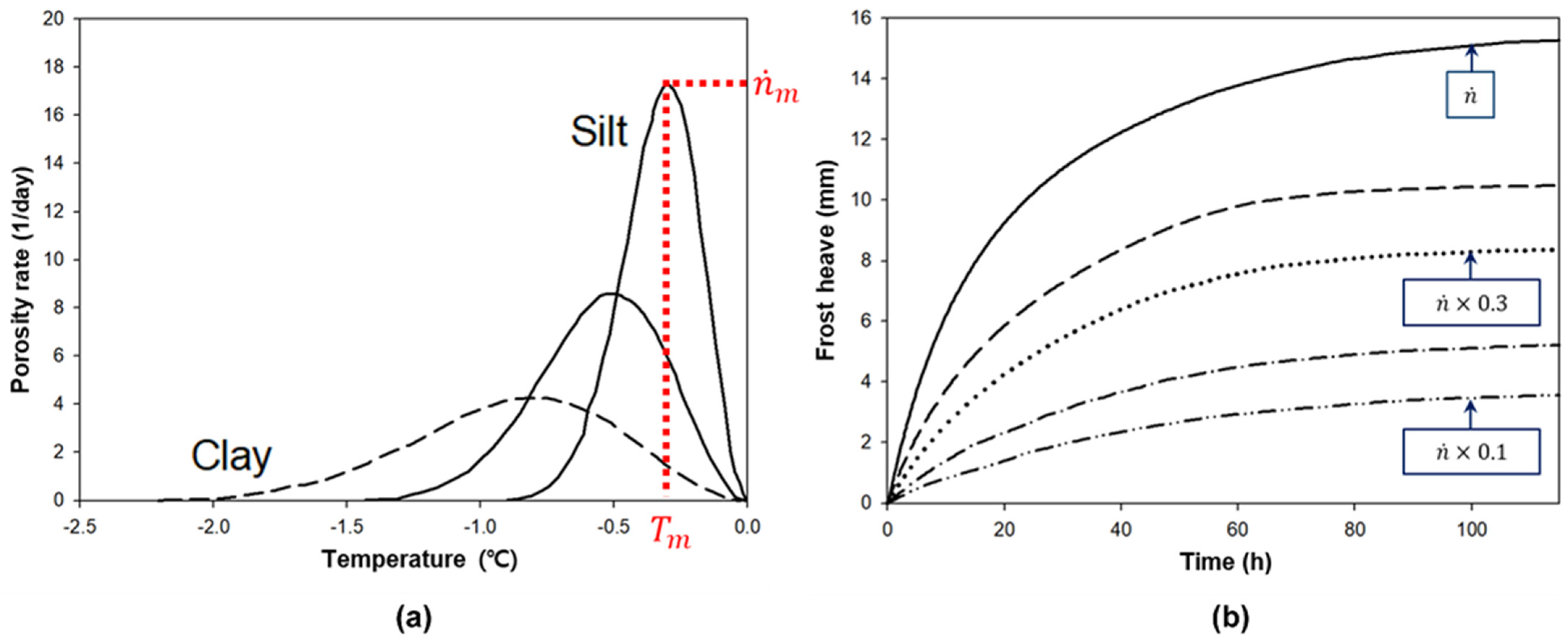
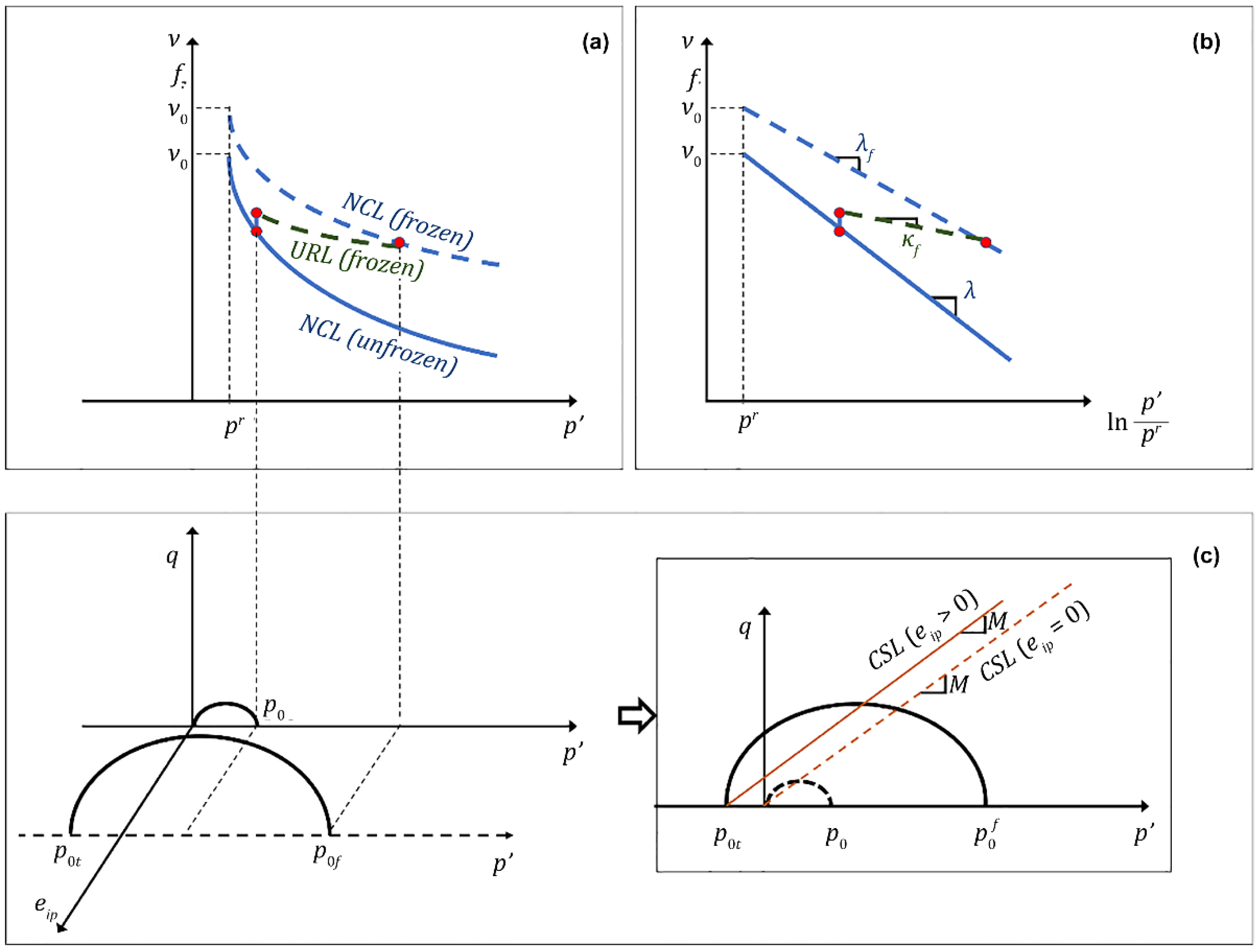
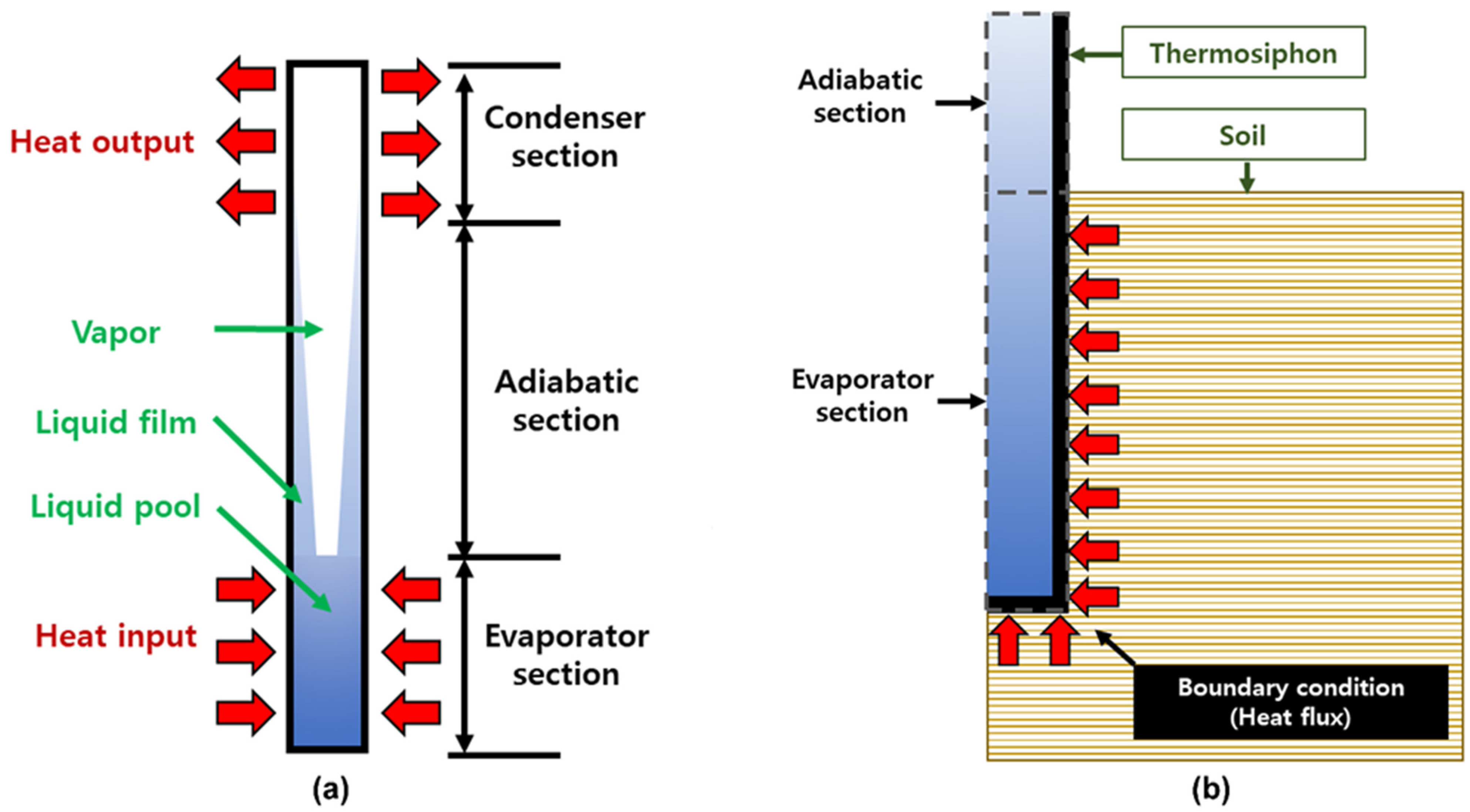

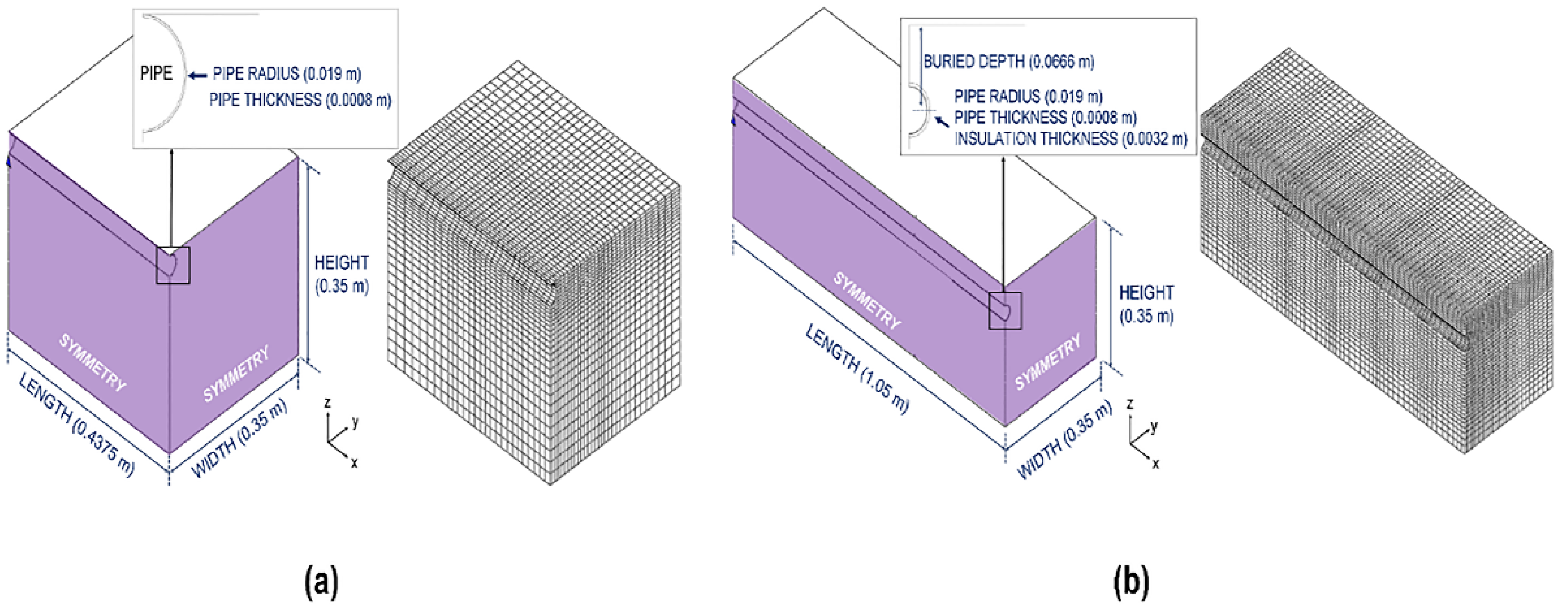


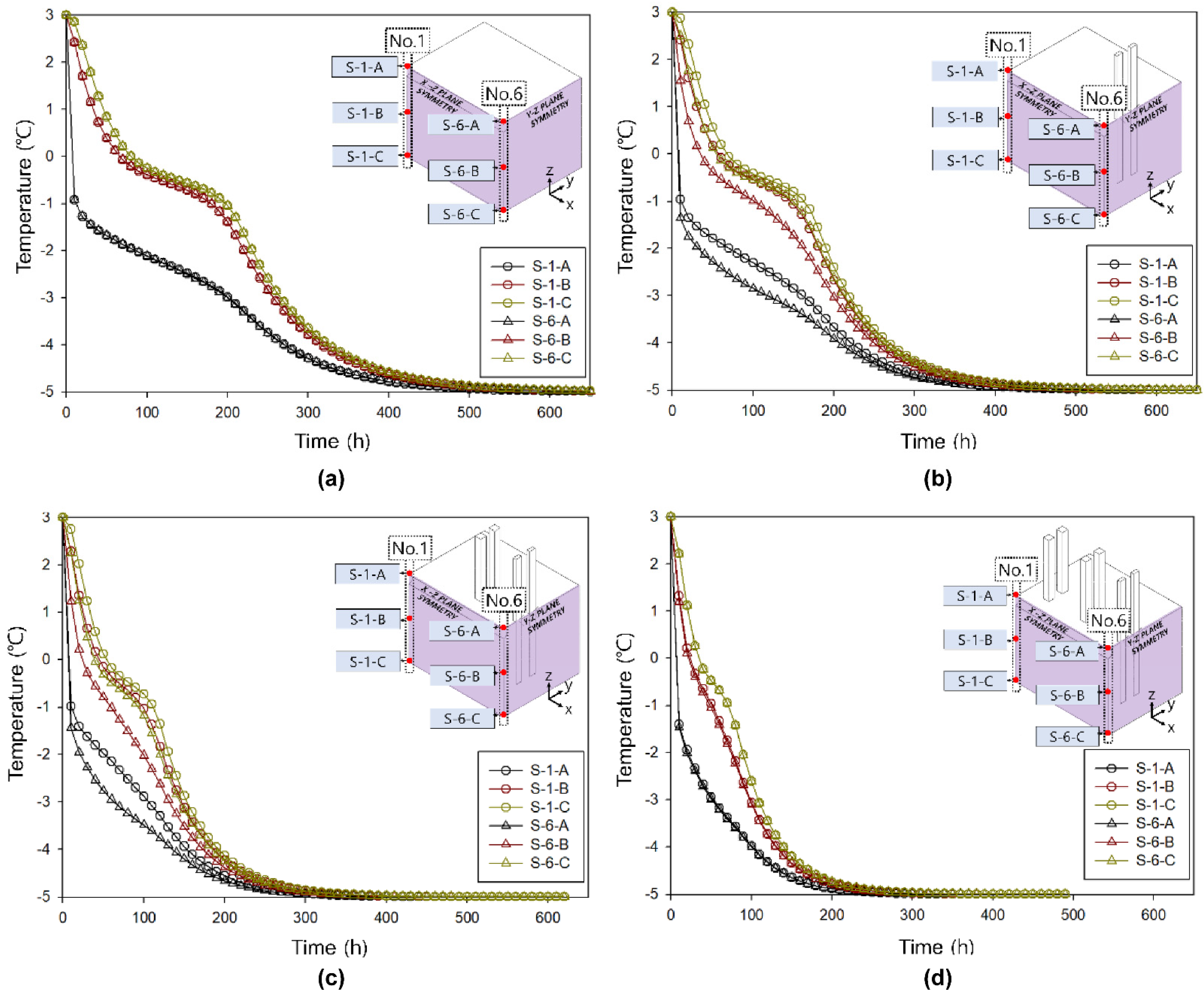

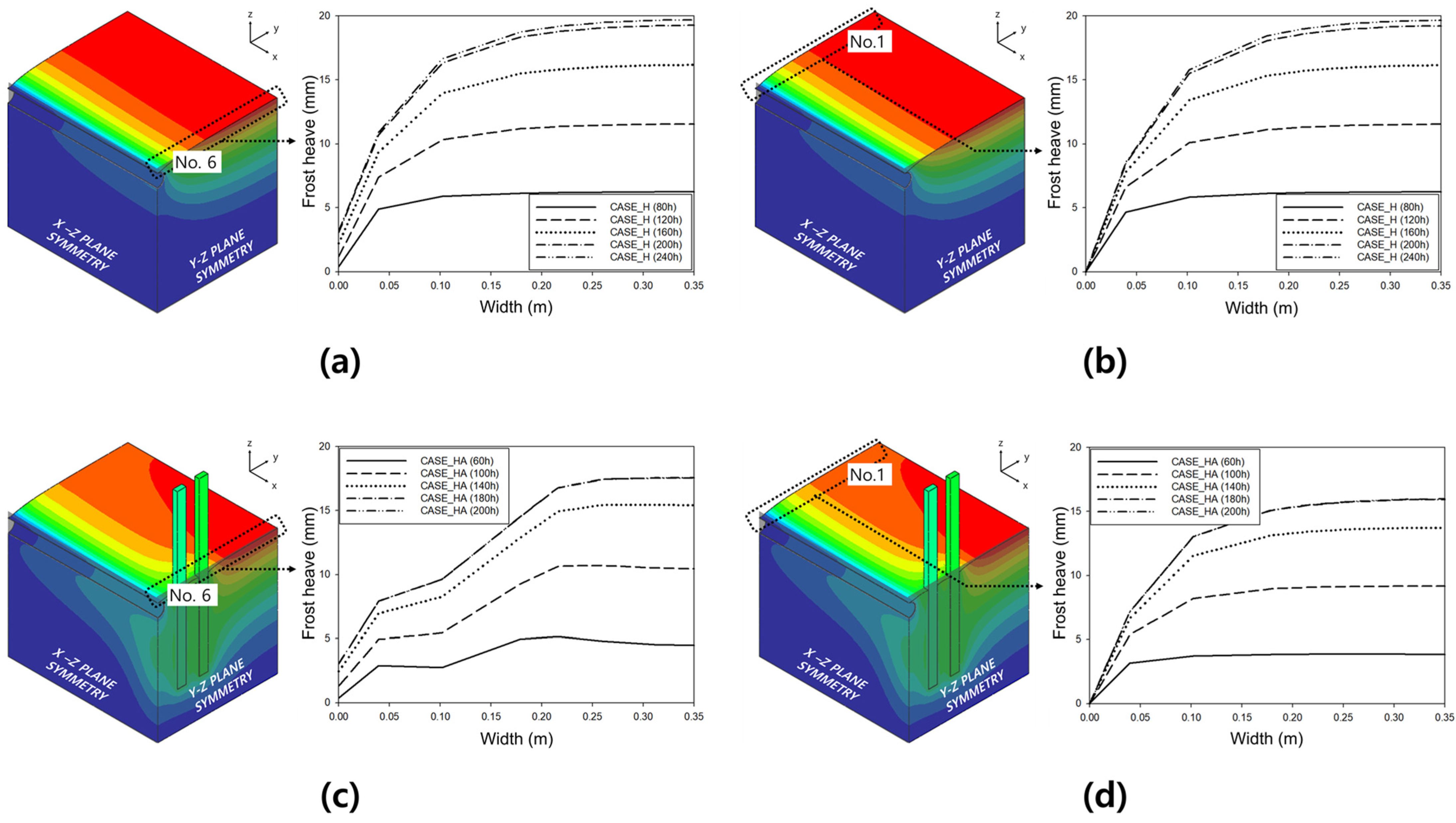
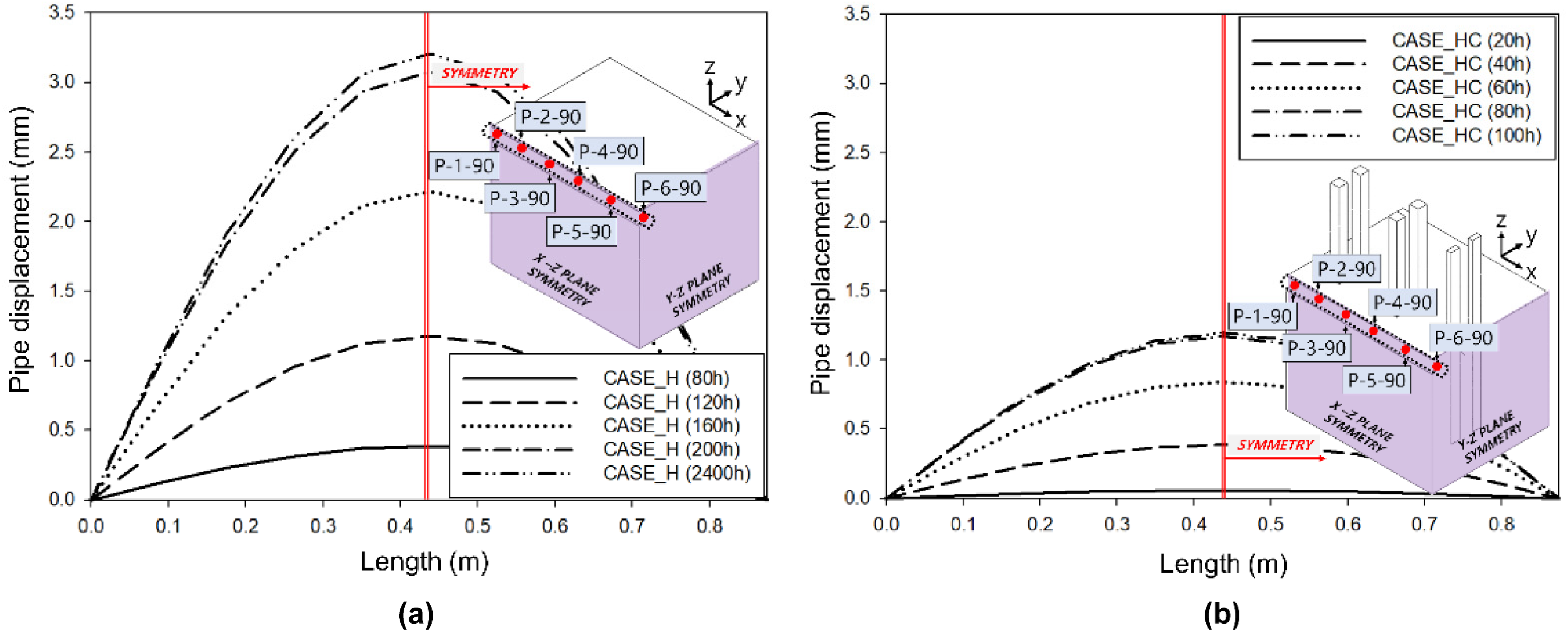
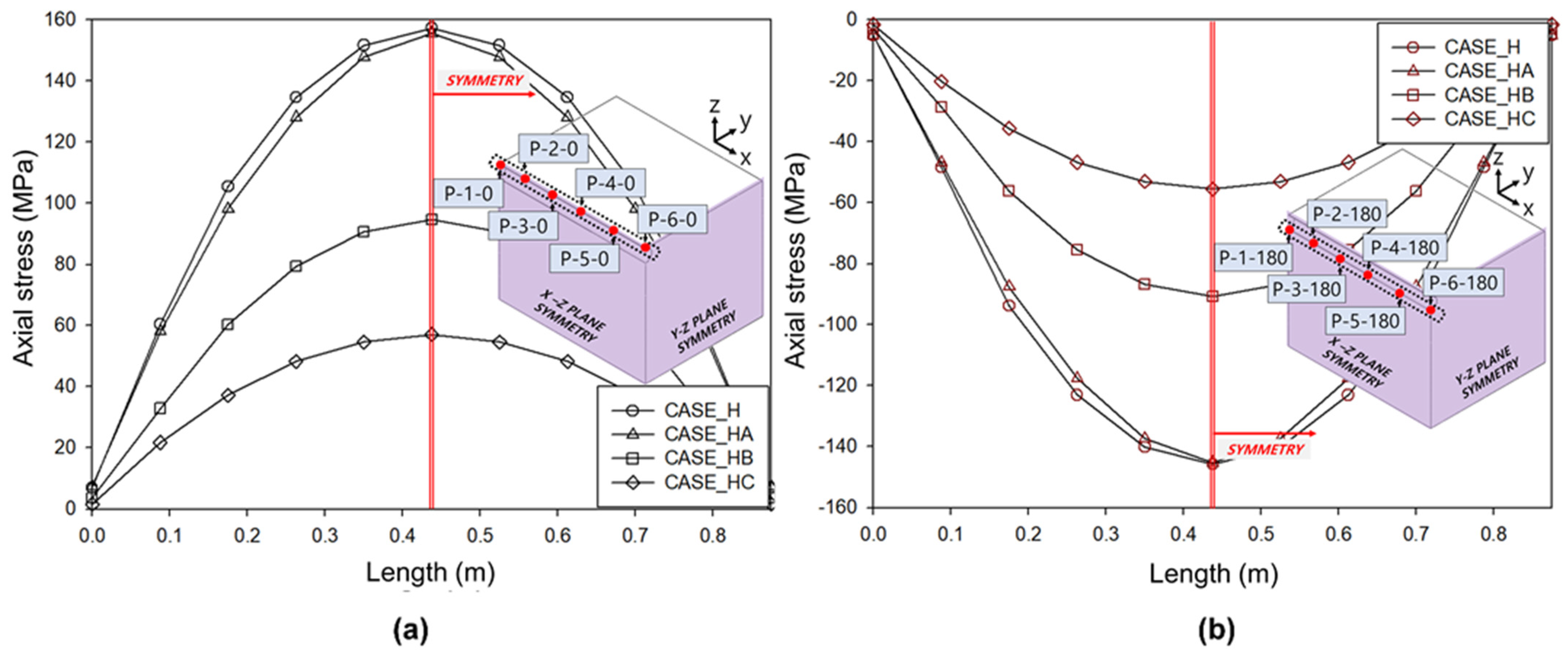

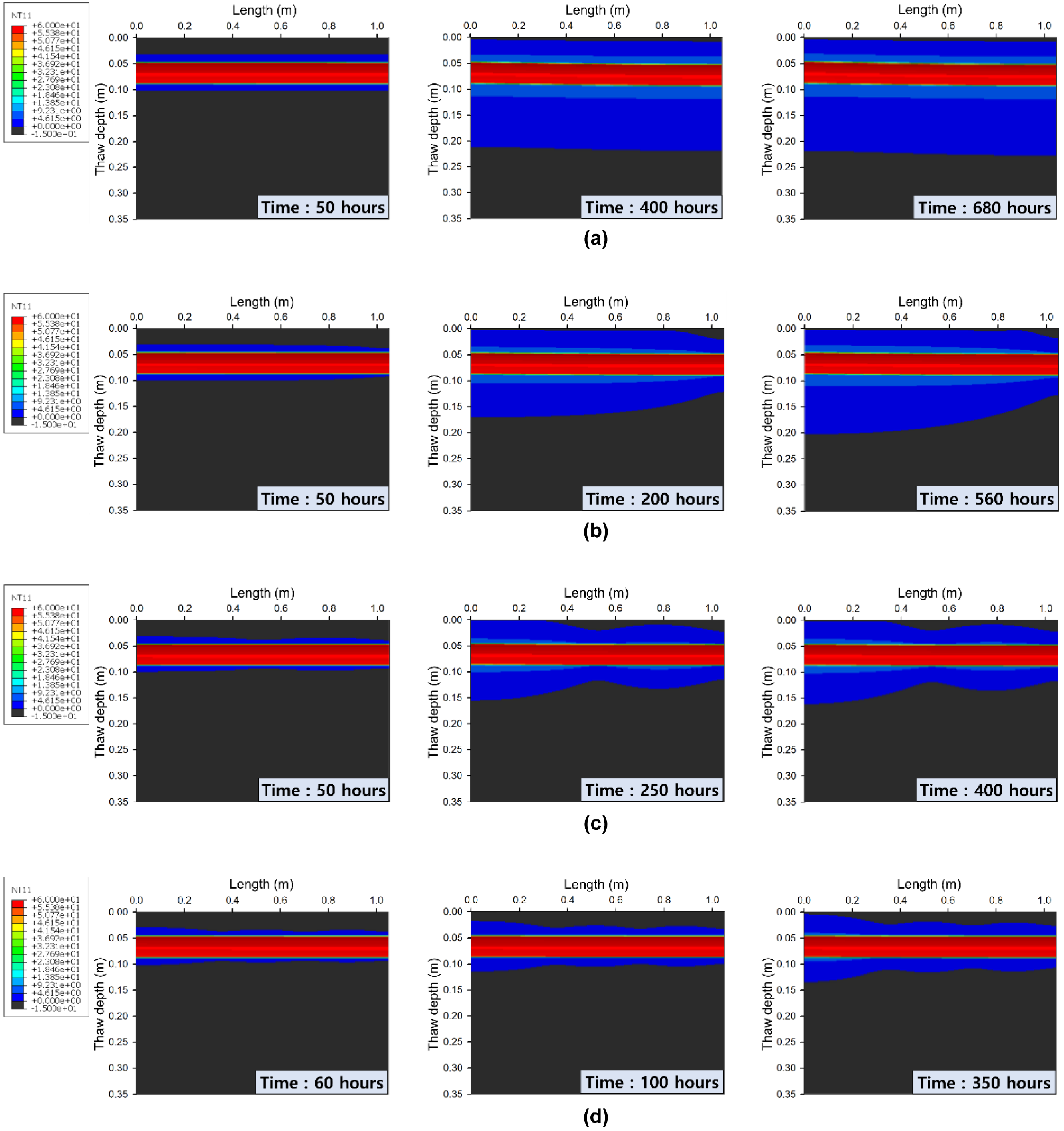
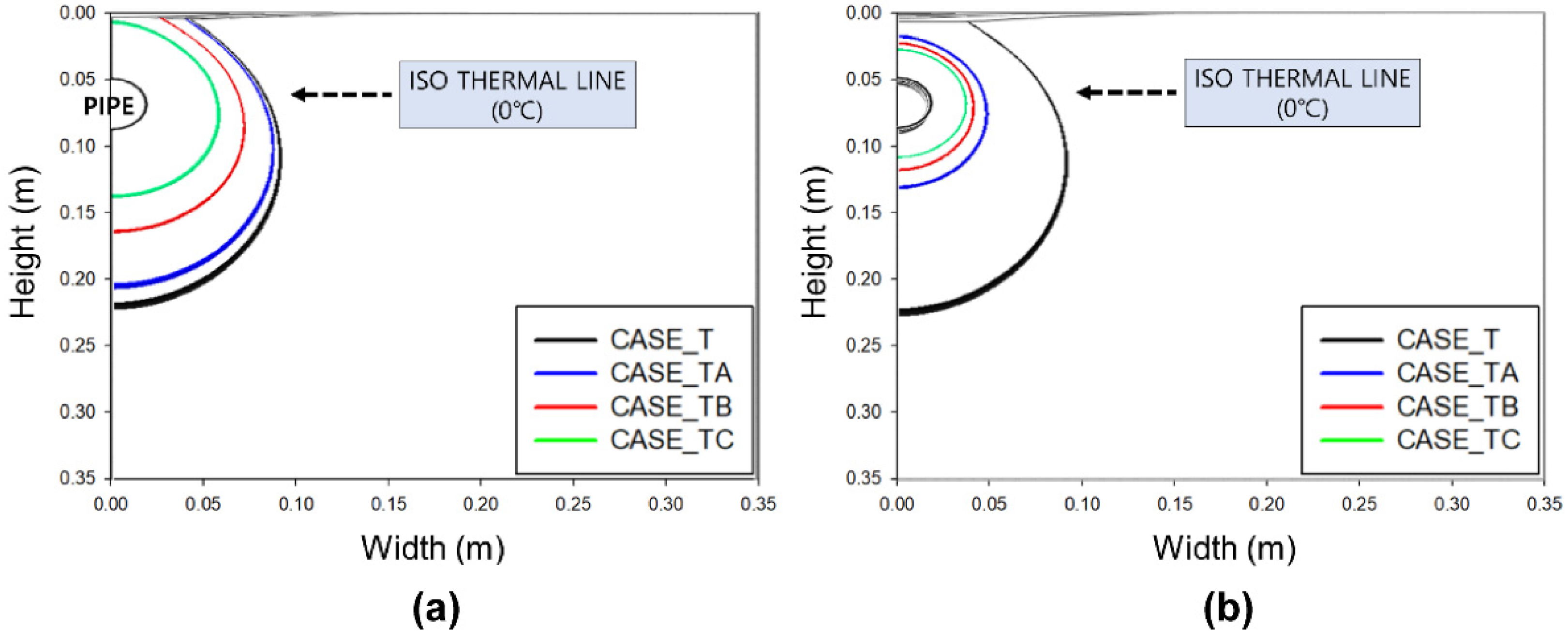


| Scenario | Case Name | Number of Thermosiphons (symmetry) | Radius of Pipeline (m) | Thickness of Pipeline (m) | Thickness of Insulation (m) | Buried Depth of Pipeline (m) | Initial Temp. (°C) | Temp. (°C) and h* (W/m2K) of Top Surface | Temp. (°C) and h (W/m2K) of Pipeline |
|---|---|---|---|---|---|---|---|---|---|
| Frost Heave | CASE_H | - | 0.019 | 0.0008 | - | 0.019 | 3 | −5 and 5 | - |
| CASE_HA | 2 pair | ||||||||
| CASE_HB | 2 | ||||||||
| CASE_HC | 3 | ||||||||
| Thaw Settlement | CASE_T | - | 0.0032 | 0.0666 | −15 | −15 and 5 | 60 and 55 | ||
| CASE_TA | 2 pair | ||||||||
| CASE_TB | 2 | ||||||||
| CASE_TC | 3 |
| Thermal Properties of Soil Mixture | |||
|---|---|---|---|
| Soil Skeleton | Water Skeleton | Ice Skeleton | |
| ) | 2620 | 1000 | 917 |
| ) | 900 | 4180 | 2000 |
| ) | 1.95 | 0.56 | 2.24 |
| Parameters for unfrozen water content of soil mixture | |||
| 0.285, 0.058 | |||
| ) | 0.16 | ||
| ) | 0 | ||
| Parameters for porosity rate function model | |||
| ) | |||
| ) | 100 | ||
| ) | −0.82 | ||
| ) | 0 | ||
| Parameters for elastic–plastic constitutive model | |||
| Poisson’s ratio | 0.3 | ||
| 0.35, 0.07, 0.7, 0.18 | |||
| 0.2, 0.4 | |||
| ) | 80, 10 | ||
Disclaimer/Publisher’s Note: The statements, opinions and data contained in all publications are solely those of the individual author(s) and contributor(s) and not of MDPI and/or the editor(s). MDPI and/or the editor(s) disclaim responsibility for any injury to people or property resulting from any ideas, methods, instructions or products referred to in the content. |
© 2023 by the authors. Licensee MDPI, Basel, Switzerland. This article is an open access article distributed under the terms and conditions of the Creative Commons Attribution (CC BY) license (https://creativecommons.org/licenses/by/4.0/).
Share and Cite
Park, D.-S.; Shin, M.-B.; Park, W.-J.; Seo, Y.-K. Numerical Analysis of Frost Heave and Thaw Settlement for Pipeline Buried in Frost-Susceptible Soil via Thermosiphons. Appl. Sci. 2023, 13, 1948. https://doi.org/10.3390/app13031948
Park D-S, Shin M-B, Park W-J, Seo Y-K. Numerical Analysis of Frost Heave and Thaw Settlement for Pipeline Buried in Frost-Susceptible Soil via Thermosiphons. Applied Sciences. 2023; 13(3):1948. https://doi.org/10.3390/app13031948
Chicago/Turabian StylePark, Dong-Su, Mun-Beom Shin, Woo-Jin Park, and Young-Kyo Seo. 2023. "Numerical Analysis of Frost Heave and Thaw Settlement for Pipeline Buried in Frost-Susceptible Soil via Thermosiphons" Applied Sciences 13, no. 3: 1948. https://doi.org/10.3390/app13031948
APA StylePark, D.-S., Shin, M.-B., Park, W.-J., & Seo, Y.-K. (2023). Numerical Analysis of Frost Heave and Thaw Settlement for Pipeline Buried in Frost-Susceptible Soil via Thermosiphons. Applied Sciences, 13(3), 1948. https://doi.org/10.3390/app13031948







